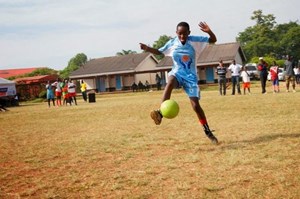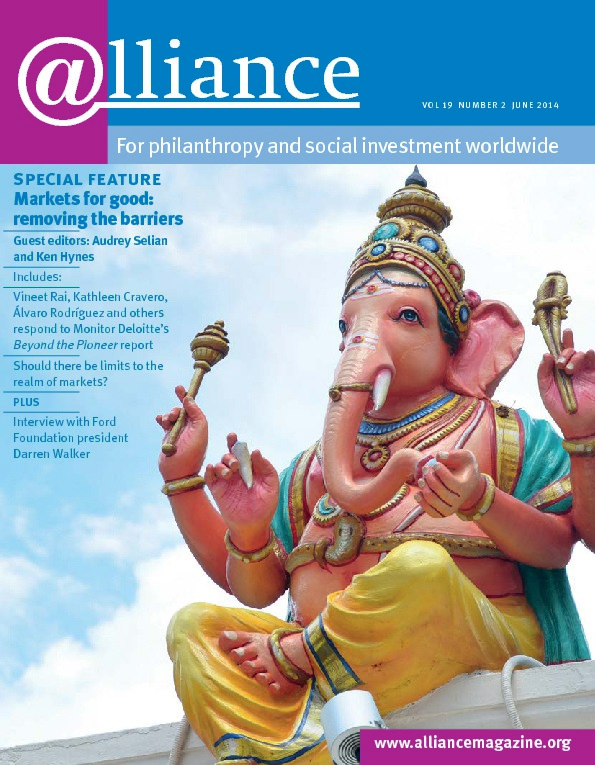‘Don’t both of you wish you had Bill Gates’ money to solve the world’s problems?’ I was sitting with Matt Flannery, co-founder of Kiva, at his engagement party earlier this year when a woman sitting across the table from us asked us this question. After hearing about the work we had begun at Kiva and GlobalGiving, the woman had asked the question in the spirit of solving some of the world’s most pressing issues in one fell swoop.
‘You know, I don’t actually think I do,’ I told her. ‘I’d rather have a thousand people giving $10 each than a single person giving $10,000 to projects on our site – because a thousand people bring a thousand different viewpoints and represent potentially a lot more engagement than any single person.’
That’s why Kiva, Network for Good, DonorsChoose.org, Indiegogo and GlobalGiving bring individuals together to solve challenges that stump individuals on their own. For those of us who carved out a unique space before ‘crowdfunding’ was even a word, we all shared a bedrock belief that by connecting as many different people as possible around shared points of interest, we would be creating new opportunities for change – or even just to fail faster.
Creating an exponential crowdfunding community
2014 has been a watershed year for many of us. As of 2013, GlobalGiving celebrated a $100 million milestone in total donations – and behind that number are more than 365,000 everyday philanthropists and progressive corporate partners funding more than 4,000 non-profit organizations in 144 countries around the world. The leading provider of donation tools to domestic non-profits and crowdfunding sites, Network for Good, had processed more than $1 billion in online donations by the beginning of 2014, handling donations to more than 100,000 non-profits. And DonorsChoose.org has helped teachers raise $237 million to fund 448,000 classroom projects for 11 million students in public schools in high poverty areas across the US. These numbers represent millions of acts of generosity democratizing aid and philanthropy at scale.
‘Democracy is all about giving the wider population access to decision-making, rather than concentrating decisions among elites,’ says Breanna DiGiammarino, cause director at Indiegogo. ‘Crowdfunding democratizes fundraising and empowers citizens to develop innovative solutions and feel the pride of participating together to make things happen within their local communities or across an ocean.’ At Indiegogo, democratizing fundraising means providing the tools and education necessary to anyone in the global community interested in running a crowdfunding campaign, whether the idea is entrepreneurial, creative or cause-related.
When they entered the scene eight years ago, the founders of Kiva posted the stories of borrowers they’d met in Uganda and tapped into their own family and friends networks to fund a small number of loans. Today, Kiva is a leader in the lending marketplace, working with microfinance institutions on five continents to provide loans to individual entrepreneurs around the world. The loans are then paid back to the lender by way of the borrower, microfinance institution and Kiva. Looking ahead, Kiva’s chief product officer Katherine Woo says: ‘We will be doing everything we can to connect people more closely, where lenders can give not just money, but also their advice and support, to the borrower. Helping another person is a very human thing. We’re headed towards a world where we create stronger connections between people across the globe, or in their own backyard.’
Fourteen years ago Dennis Whittle and I left the World Bank to get out of the business of allocating scarce resources across nations and loans and instead to create an environment where more ideas and creativity could connect more and more people in building community wealth. We believed that anyone with an idea about how to change his or her community should have a chance to get that idea heard and funded. Today at GlobalGiving, we are a small team of 30 based in Washington DC, but our network is far bigger. We have the biggest corporations in the world like Microsoft matching gifts from individual donors to the smallest non-profits that are making a big impact in all corners of the world.
Challenges of a crowded crowdfunding marketplace: scale, sustainability, security and social impact
At the last count, there were already 700 crowdfunding platforms worldwide, with no signs of slowing. According to Stacie Kronthal, senior vice president of partnerships at Network for Good, their Digital Giving Index shows that online giving is growing at a rate of 14 per cent compared to a 4 per cent growth rate for overall giving – and there’s still much room for growth with only 10 per cent of total giving accounted for by online giving. In this context, the burden is on every crowdfunding site to show that it has a strategy to mitigate any risks involved and offer demonstrable social impact.
Scale and sustainability
According to Devin Thorpe, Forbes’ contributor covering social entrepreneurship and impact investing, ‘there are now so many crowdfunding sites targeting social good that some, especially those that offer no particular point of distinction, are failing to gain enough traction to put them on track for becoming economically viable. It is too soon to tell, yet, how many platforms will ultimately reach a point of being self-sustaining.’
For many of us, achieving a sustainable model that works at scale has been just one piece of the puzzle. DonorsChoose.org and GlobalGiving both achieved 100 per cent cost recovery over three years ago, something you’d be hard pressed to find in the non-profit and philanthropic sector. But beyond scale, maintaining a focused approach is key to success. Charles Best, founder of DonorsChoose.org, believes that ‘one of our biggest challenges is maintaining our focus on what we do best, which often means resisting the urge to expand geographically or beyond education’.
Security
Transparency is another essential ingredient for building relationships of trust in the crowdfunding community. At GlobalGiving, we go through a rigorous due diligence process to seek the non-profits that have a track record of commitment in the communities they are serving. Woo at Kiva remarks: ‘We learned that education and transparency are essential to our borrower-lender ecosystem. We’ve invested in making our vetting and monitoring processes transparent to lenders, while protecting our borrowers and our continuously evolving brand.’
On the proliferation of crowdfunding sites, she continues: ‘We’re seeing a lot of innovation in the crowdfunding and social entrepreneurship world. I think there will be a period of fragmentation with all the newcomers to the scene. But I do wonder if there will come a time when various marketplaces will get hit with safety issues – that there will be a sifting out of winners versus losers.’
There’s no doubt that the crowdfunding space has already seen its share of issues with security, but just how much responsibility and risk any crowdfunding site should bear is still a grey area that is surfacing as more and more crowdfunding sites are hit hard with cases of fraudulent crowdfunding.
Social impact
Crowdfunding favours urgent and tangible needs such as disaster relief, or heart surgery for a specific individual. It is not necessarily effective in mobilizing deep, sustained support, and may even ‘crowd out’ public policy challenges like universal healthcare. But I believe we have yet to realize the full potential of the crowd in what we are doing as crowdfunding platforms. Crowds are, as James Surowiecki puts it in The Wisdom of Crowds, ‘remarkably intelligent, and are often smarter than the smartest people in them’. One way of ensuring that crowdfunding does not displace other types of giving for less tangible, longer-term causes is to fully leverage this potential for rich collaboration.
As crowdfunding intermediaries, we test this hypothesis daily. As we see it, the trick to unlocking the greatest potential of the platform lies in harnessing the power of collaboration in novel ways. In our laboratory, we are beta testing some new products and tools while continuously making changes to meet the changing needs of our partners so that the right resources can flow to support capacity that is already in the field. Crowdfunding sites are well poised to do this – after all, we have the eyes and ears of the crowd. Now is the time to figure out how crowdfunding platforms can channel funds not just to benefit the most direct, immediate and emotionally compelling needs but also initiatives that are measurably more effective.
 Getting at effectiveness
Getting at effectiveness
Big data is in danger of getting overhyped. But it is particularly well suited to being combined with crowdfunding. At GlobalGiving, big data lets us find even smarter ways to match up our long tail of projects with donor demand while making it possible for more resources to flow to higher-performing organizations. And this is possible only because we are able to leverage the deep customized data we have about our crowdfunding partners. (Pictured: With help from the SOLD Project, a GlobalGiving project, girls in Thailand are finding freedom from human trafficking.)
In America’s public school system, big data could translate into a massive opportunity. Best at DonorsChoose.org argues that: ‘As more people use crowdfunding platforms, these sites will gather data about people’s needs. By opening up this significant statistical resource, we have exposed what teachers really need most. Maybe, just maybe, such insights could make government education spending smarter, more efficient, and more responsive to classroom needs as they emerge.’
 In the Rift Valley of Kenya, we partnered with a small organization called the Trans-Nzoia Youth Sport Association (TYSA) using one of our pilot tools to collect narrative feedback from the constituents they were serving. Before participating in the programme, TYSA had been running after-school programmes focused on soccer and leadership for youth in the community. But as stories began to filter in about violence by police against youth and sexual abuse, TYSA found that none of the programmes they had were addressing the more critical needs of the community. And so they changed tack and began to consider new strategies, like working with the police as youth advocates. On our crowdfunding platform, we give organizations points for when they start listening to their constituents, and this translates into better visibility through access to donors and inclusion in new corporate programmes. So for all the TYSAs that we work with all around the world, there is tremendous potential for quality work to have a greater impact. (Pictured: Youth in Kenya playing for peace in TYSA’s Football for Hope programme.)
In the Rift Valley of Kenya, we partnered with a small organization called the Trans-Nzoia Youth Sport Association (TYSA) using one of our pilot tools to collect narrative feedback from the constituents they were serving. Before participating in the programme, TYSA had been running after-school programmes focused on soccer and leadership for youth in the community. But as stories began to filter in about violence by police against youth and sexual abuse, TYSA found that none of the programmes they had were addressing the more critical needs of the community. And so they changed tack and began to consider new strategies, like working with the police as youth advocates. On our crowdfunding platform, we give organizations points for when they start listening to their constituents, and this translates into better visibility through access to donors and inclusion in new corporate programmes. So for all the TYSAs that we work with all around the world, there is tremendous potential for quality work to have a greater impact. (Pictured: Youth in Kenya playing for peace in TYSA’s Football for Hope programme.)
And that’s exactly what the next decade at GlobalGiving will be about. We’ll be helping every single organization on our crowdfunding platform by providing the tools they need to work smarter. Every week, some 40 per cent of the partners we work with log into our system – think of us as a laboratory where thousands of non-profits worldwide can come and test new tools to improve their effectiveness. And like a real behavioural lab, we can offer incentives in the form of access to different funding streams. This combination of performance improvement with funds offers us an opportunity to engage non-profits to learn with us.
Crowdsourcing solutions to poverty
Looking ahead, it’s not so hard to imagine a world where crowdfunding will become a household word around the globe. Says DiGiammarino: ‘Today, it’s hard to find someone who has never run a crowdfunding campaign, contributed to a crowdfunding campaign, enjoyed a product made possible by a crowdfunding campaign, or even just shared a crowdfunding campaign through social media. Crowdfunding is becoming more and more a part of every person’s lexicon and we’re confident it’s on its way to becoming a normal part of the fundraising process, enabling organizations’ strongest supporters to share the value of their diligence with their network.’
The emerging promise of crowdfunding is that we can create a more direct connection between the donor and the causes and people they are supporting. This is already bringing into the fray people who otherwise might not have thought about contributing to the public good. That is unequivocally a good thing. But the full promise of crowdfunding lies in the crowd, not the funding. Mission-driven crowdfunding platforms have the ability to leverage the deep networks they’ve created to crowdsource not just money, but also world-saving information, ideas and connections.
Mari Kuraishi is co-founder and president of GlobalGiving. Email mkuraishi@globalgiving.org
We would like to thank our friends at Indiegogo, Kiva, Network for Good, DonorsChoose.org, and Devin Thorpe for their contributions to this article.




Comments (0)